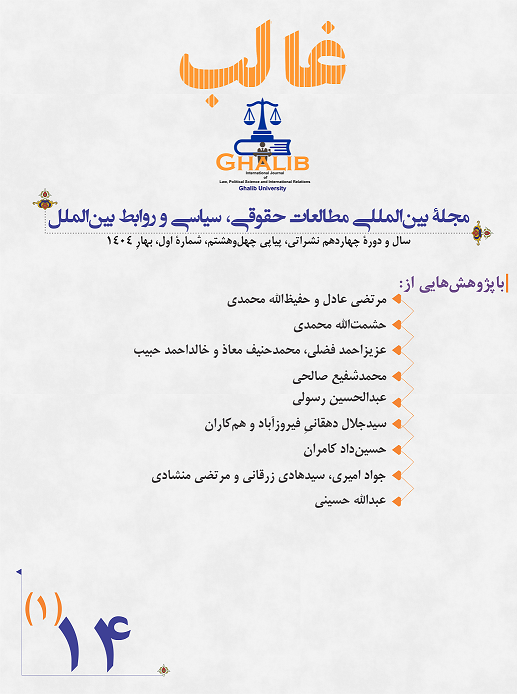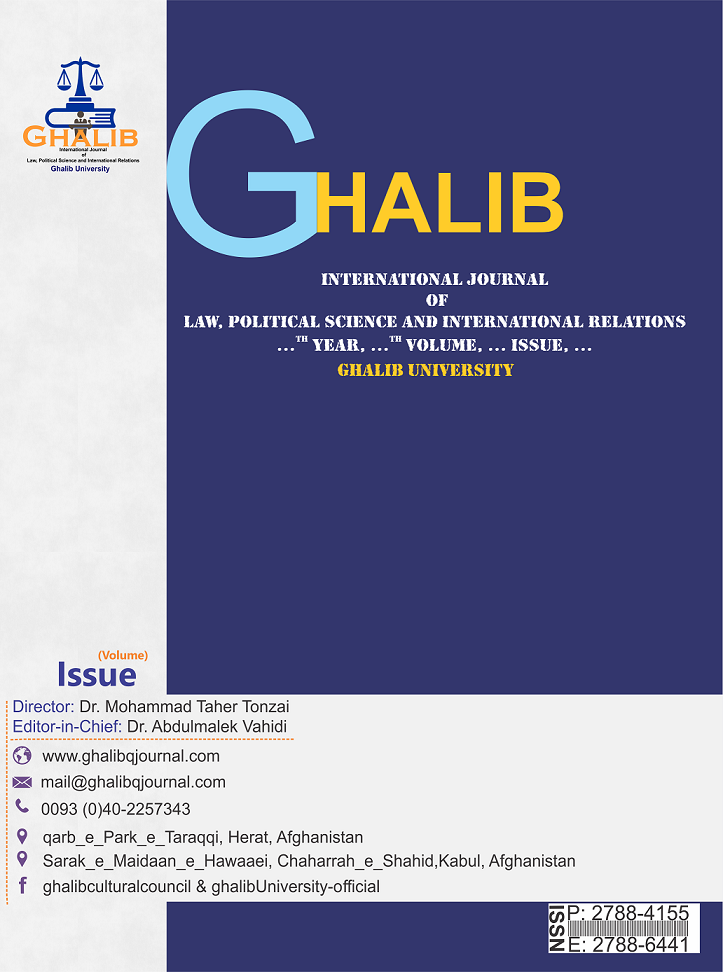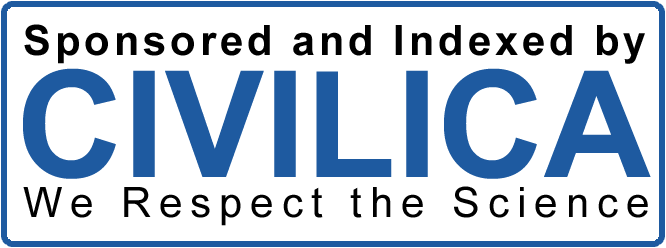The Role of Afghanistan's Foreign Policy and Diplomatic Apparatus in Combating Narcotics
DOI:
https://doi.org/10.58342/ghalibqj.V.14.I.1.4Keywords:
Afghanistan, Foreign Policy, Diplomatic Apparatus, Combating NarcoticsAbstract
Combating narcotics is one of Afghanistan’s most pressing challenges. This research examines the role of Afghanistan’s foreign policy and diplomatic apparatus in managing this crisis through strengthening regional and international cooperation. The significance of this study lies in its exploration of collaborative opportunities with other countries and international organizations to counter the production, trafficking, and consumption of narcotics. The central research question is: How can Afghanistan’s foreign policy and diplomatic apparatus play an effective role in reducing the narcotics crisis through the enhancement of international and regional cooperation? This study adopts a mixed-methods approach, employing both analytical and descriptive methods, with data collected and analyzed from library sources. The findings indicate that Afghanistan’s foreign policy and diplomacy can positively contribute to reducing narcotics production and trafficking by leveraging regional cooperation, utilizing international treaties, and attracting technical and financial assistance. Additionally, enhancing the capacity of the diplomatic apparatus, expanding relations with transit-route countries, and implementing joint anti-narcotics programs are of critical importance. These measures can help mitigate the security, economic, and social issues associated with narcotics while reinforcing Afghanistan’s image as an active partner in the global fight against drugs. The study’s results can assist policymakers and researchers in developing more effective strategies to address this crisis
References
Amirkhizi, Mohammad Reza. (1999). “International Community’s Measures in Combating Narcotics.” Foreign Policy Journal, pp. 953–966. http://ensani.ir/fa/article/97942] In Persian[
Jalali, Reza; Almasi, Fazel. (2010). “Challenges Facing NATO in Establishing Security in Afghanistan.” Daneshnameh (Political Science), (78), pp. 39–62. https://sid.ir/paper/91286/fa] In Persian[
Dastaranj, Shahram. (2017). Diplomacy of Combating Narcotics. Mashhad: Asar-e Fekr.] In Persian[
Yazdani, Enayatollah; Badakhshan, Mojtaba. (2014). “The Impact of Narcotics Production and Trade on Afghanistan’s Security (Post-2001).” Iranian Journal of International Politics Research, 3(1), pp. 118–140. https://doi.org/10.22067/jipr.v3i15.42127] In Persian[
Bayer, I. (1989). Development of the Convention on Psychotropic Substances, 1971. Unpublished manuscript. https://bpb-us-e1.wpmucdn.com/blogs.uoregon.edu/dist/3/14638/files/2021/08/Spring2021Volume19.pdf
Byrd, W., & Ward, C. (2004). Drugs and development in Afghanistan. https://documents1.worldbank.org/curated/en/156391468740439773/pdf/30903.pdf
Cordesman, A. H. (2022). Civil Half of the Afghan War: Dealing with the Political, Governance, Economics, Corruption, and Drug Threats. Center for Strategic and International Studies (CSIS). https://csis-website-prod.s3.amazonaws.com/s3fs-public/publication/171206_Afghanistan_The_Other_Half_of_the_War.pdf
Corti, D., & Swain, A. (2009). War on drugs and war on terror: Case of Afghanistan. Peace and Conflict Review, 3(2), 41-53. https://citeseerx.ist.psu.edu/document?repid=rep1&type=pdf&doi=84d36cc7d6886ab46d8471f9a4badb24b19121f2
Coyne, C. J., Blanco, A. R. H., & Burns, S. (2016). The war on drugs in Afghanistan: another failed experiment with interdiction. The Independent Review, 21(1), 95-119. https://papers.ssrn.com/sol3/Delivery.cfm?abstractid=2613428
Crick, E. (2012). Drugs as an existential threat: An analysis of the international securitization of drugs. International Journal of Drug Policy, 23(5), 407-414. https://www.academia.edu/download/25314931/CrickE_Drugs_as_an_existential_threat_2012.pdf
Demirbuken, H. (2016). Drug Money Flows and Its Links with Terrorism Financing: The Case of Afghanistan. In Countering Terrorist Recruitment in the Context of Armed Counter-Terrorism Operations (pp. 119-129). IOS Press. https://ebooks.iospress.nl/volumearticle/42168
Don, A. E. (2014). Lighten Up: Amending the Single Convention on Narcotic Drugs. Minn. J. Int'l L., 23, 213. https://scholarship.law.umn.edu/cgi/viewcontent.cgi?article=1278&context=mjil
Felbab-Brown, V. (2016). No easy exit: Drugs and counternarcotics policies in Afghanistan. Washington DC: Brookings. https://www.brookings.edu/wp-content/uploads/2016/07/FelbabBrown-Afghanistan-final.pdf
Goodhand, J. (2005). Frontiers and wars: the opium economy in Afghanistan. Journal of Agrarian Change, 5(2), 191-216. https://www.academia.edu/download/50636978/Frontiers_and_Wars_the_Opium_Economy_in_20161130-24006-1wtlv5m.pdf
Jenner, M. S. (2011). International drug trafficking: A global problem with a domestic solution. Indiana Journal of Global Legal Studies, 18(2), 901-927. https://www.repository.law.indiana.edu/cgi/viewcontent.cgi?article=1465&context=ijgls
Jones, S. G. (2006). Averting failure in Afghanistan. Survival, 48(1), 111-128.
https://www.tandfonline.com/doi/abs/10.1080/00396330600594306
Kienberger, S., Spiekermann, R., Tiede, D., Zeiler, I., & Bussink, C. (2017). Spatial risk assessment of opium poppy cultivation in Afghanistan: integrating environmental and socio-economic drivers. International Journal of Digital Earth, 10(7), 719-736 https://scholar.google.com/scholar?output=instlink&q=info:kxwwGLQ7KcJ:scholar.google.com/&hl=en&as_sdt=0,5&scillfp=7412231606744154485&oi=lle
Kutty, S. N. (2014). Iran's Continuing Interests in Afghanistan. The Washington Quarterly, 37(2), 139-156. https://papers.ssrn.com/sol3/Delivery.cfm?abstractid=2463490
Mansfield, D., & Pain, A. (2008). Counter-narcotics in Afghanistan: The failure of success?. Kabul: Afghanistan Research and Evaluation Unit. https://gisf.ngo/wp-content/uploads/2014/09/0020-Mansfield-Pain-2008-Counter-narcotics-in-Afghanistan8.pdf
Mansfield, D. (2006). Responding to the challenge of diversity in opium poppy cultivation in Afghanistan. Introduction And Overview, 47. https://documents1.worldbank.org/curated/es/151161467996726308/pdf/389310AF0Drug0industry0Nov200601PUBLIC1.pdf#page=55
Mejía, D., & Restrepo, P. (2008). The war on illegal drug production and trafficking: An economic evaluation of Plan Colombia. Documento CEDE, (2008-19). https://papers.ssrn.com/sol3/Delivery.cfm?abstractid=1485690
Modebadze, V. (2022). Afghanistan under Taliban: a new regime poses a threat to international stability. Journal of Liberty and International Affairs, 8(1), 277-291. https://e-jlia.com/index.php/jlia/article/download/488/282
Morales, W. Q. (1989). The war on drugs: a new US national security doctrine?. Third World Quarterly, 11(3), 147-169. https://www.researchgate.net/profile/Waltraud_Morales/publication/261578921_The_war_on_drugs_A_new_US_national_security_doctrine/links/54fb63b70cf270426d0dcc1a/The-war-on-drugs-A-new-US-national-security-doctrine.pdf
Rinaldi, M., Pedrason, R., & Wirajuda, M. H. (2024). Indonesia's Foreign Policy in Dealing with Non-Traditional Threats (Case Study Drugs Trafficking in Indonesia). East Asian Journal of Multidisciplinary Research, 3(2), 773-786. https://journal.formosapublisher.org/index.php/eajmr/article/download/8520/8353
Saghafi-Ameri, N. (2010). The “Afghan Drugs” Problem–A challenge to Iran and International security. Iranian review of foreign affairs, 1(2), 213-235. https://www.unodc.org/documents/islamicrepublicofiran/publications/IRIRAN/The_Afghan_Drugs_Problem_and_Iran-Saghafi-Ameri-2010.pdf
Stepanova, E. (2012). Illicit drugs and insurgency in Afghanistan. Perspectives on terrorism, 6(2), 4-18. https://jamesforest.com/wp-content/uploads/2017/04/6-2.pdf
Stippel, J. A., & Serrano-Moreno, J. E. (2020). The coca diplomacy as the end of the war on drugs. The impact of international cooperation on the crime policy of the Plurinational state of Bolivia. Crime, Law and Social Change, 74(4), 361-380. https://www.researchgate.net/publication/341032837_The_coca_diplomacy_as_the_end_of_the_war_on_drugs_The_impact_of_international_cooperation_on_the_crime_policy_of_the_Plurinational_state_of_Bolivia
United Nations. (1991). United Nations Convention Against Illicit Traffic in Narcotic Drugs and Psychotropic Substances, 1988: Adopted by the Conference at Its Sixth Plenary Meeting on 19 December 1988. New York: United Nations.
Xinwei, L. (2019). The drug situation and the practice of drug control in Afghanistan. Himalayan and Central Asian Studies, 23(3/4), 194-0_4. https://search.proquest.com/openview/debe8ba46bf97cc550c203a2d4a1bda4/1?pq-origsite=gscholar&cbl=1036373
Blanchard, C. M. (2007, December). Afghanistan: Narcotics and us policy. Congressional Information Service, Library of Congress. https://apps.dtic.mil/sti/pdfs/ADA506102.pdf
Downloads
Published
How to Cite
Issue
Section
License
Copyright (c) 2025 عزیزاحمد فضلی،محمدحنیف معاذ،خالداحمد حبیب

This work is licensed under a Creative Commons Attribution 4.0 International License.













